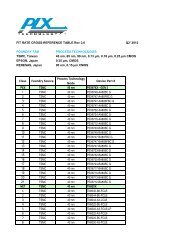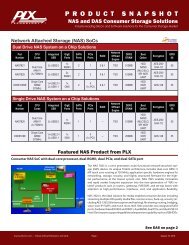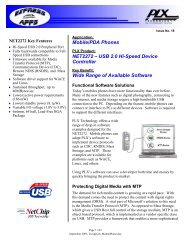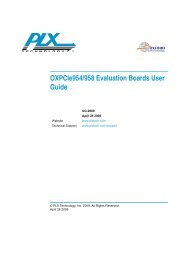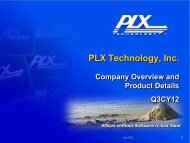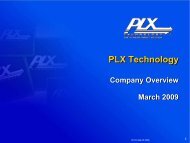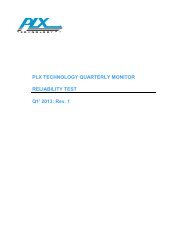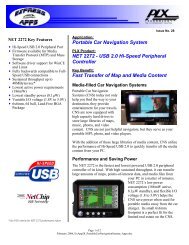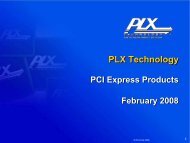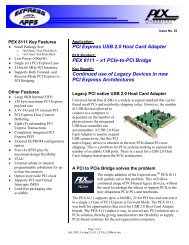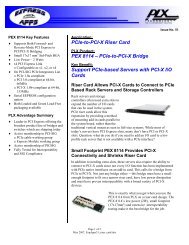the 2009 Annual Report (pdf) - PLX Technology
the 2009 Annual Report (pdf) - PLX Technology
the 2009 Annual Report (pdf) - PLX Technology
You also want an ePaper? Increase the reach of your titles
YUMPU automatically turns print PDFs into web optimized ePapers that Google loves.
<strong>the</strong> data rate has doubled to 5.0 Gigabits per second. We are in development of Gen 3 PCI Express supporting 8.0<br />
Gigabits per second.<br />
PCI Express Bridges. PCI Express Bridges enable conventional PCI products (32-bit/33 MHz, 32-bit/66 MHz<br />
and even 64-bit/133 MHz PCI-X) to be upgraded for use in new PCI Express systems. This allows users to quickly<br />
bring a new product to market. Applications using <strong>the</strong>se bridge devices include servers, storage host bus adapters,<br />
graphics, TV tuners and security systems. The reverse bridging feature also allows users to bridge backwards<br />
allowing <strong>the</strong> latest PCI Express based powerful CPUs/Graphics processors to still service and support <strong>the</strong> legacy PCI<br />
and PCI-X market. We also offer bridges that translate PCI Express to general purpose serial and parallel ports.<br />
Direct Attached Storage (DAS). DAS devices are System-on-a-Chip (SOC) products that allow external storage<br />
to be easily connected to a PC through ei<strong>the</strong>r a USB, 1394, or external Serial ATA connection. <strong>PLX</strong> products offer<br />
<strong>the</strong> widest range of connection possibilities, and <strong>the</strong> most complete feature set, including single, dual, and quad hard<br />
disk connection, RAID, and encryption. The <strong>PLX</strong> devices have industry leading performance across all interfaces.<br />
Network Attached Storage (NAS). NAS products provide storage that attaches to a Local Area Network (LAN).<br />
<strong>PLX</strong> NAS products are aimed at <strong>the</strong> consumer/SOHO market, and are SOC devices that combine E<strong>the</strong>rnet, USB, PCI<br />
Express and SATA ports with o<strong>the</strong>r standard interfaces necessary to complete a state-of-<strong>the</strong>-art network appliance.<br />
<strong>PLX</strong> products include a PCI interface to easily create complete subsystems, a DDR DRAM interface, and on-chip<br />
capabilities such as TCP off-load, RAID, and encryption. These basic building blocks are enabled with high<br />
performance firmware that runs on a powerful, low power ARM processor.<br />
PCI Bridges. <strong>PLX</strong> offers a range of general purpose bridges that translate and extend <strong>the</strong> PCI bus. These<br />
products offer a bridge between <strong>the</strong> PCI and a variety of o<strong>the</strong>r serial and parallel general purpose interfaces. Our<br />
PCI-to-PCI bridges are chips that increase <strong>the</strong> number of peripheral devices that can be included in a microprocessorbased<br />
system. <strong>PLX</strong>’s bridge product line spans <strong>the</strong> entire PCI range, from 32-bit 33MHz through 64-bit 66MHz, and<br />
includes 133MHz PCI-X devices.<br />
USB Interface Chips. USB interface chips are used by computer peripherals to connect to a PC through an<br />
external cabled connection. The current mainstream version of this spec, called USB 2.0, can be found today on<br />
devices like multi-function printers, DVD camcorders, portable media players, portable navigation systems, digital<br />
cameras, PDAs and hard disks. Our USB interface chips offer connection to both PCI or to a generic interface,<br />
providing a simple connection that offers high performance. We are in development of products using USB 3.0 which<br />
offers 5.0 Gigabit per second transfers.<br />
Customers<br />
We supply our products to <strong>the</strong> leading companies in <strong>the</strong> server, enterprise and consumer storage, communications,<br />
pc peripheral, consumer and embedded markets, and more than 1,000 electronic equipment manufacturers incorporate<br />
our semiconductor devices in <strong>the</strong>ir systems. Since <strong>the</strong> products that we design and sell have innovative features, and<br />
since <strong>the</strong>re is normally a software impact to <strong>the</strong> vendor choice, <strong>the</strong> customer design team typically selects <strong>the</strong> solesource<br />
hardware and software components early in <strong>the</strong> design cycle. Generally, <strong>the</strong> system will incorporate <strong>the</strong>se<br />
same components throughout its product life because changes require an expensive re-engineering effort. Therefore,<br />
when our products are designed into a system, <strong>the</strong>y are likely to be used in that system throughout its production life.<br />
Competition<br />
Competition in <strong>the</strong> semiconductor industry is intense. If our target markets continue to grow, <strong>the</strong> number of<br />
competitors may increase significantly. In addition, new semiconductor technologies may lead to new products that<br />
can perform similar functions as our products.<br />
We believe that <strong>the</strong> principal factors of competition in our business include functionality, product performance,<br />
price, product innovation, availability of development tools, customer service and reliability. We believe that we<br />
compete favorably with respect to each of <strong>the</strong>se factors. We differentiate our products from those of our competitors<br />
by incorporating innovative features that allow our customers to build systems based on industry standards that<br />
provide more features, and higher performance. Fur<strong>the</strong>rmore, in general, our software and hardware development<br />
7




